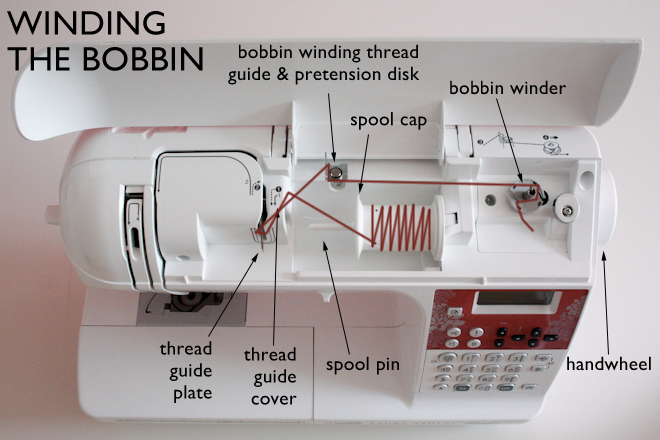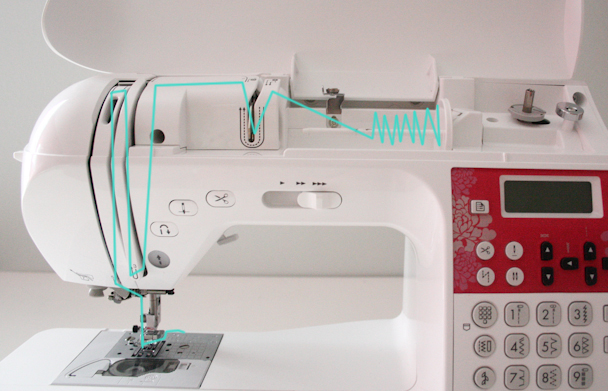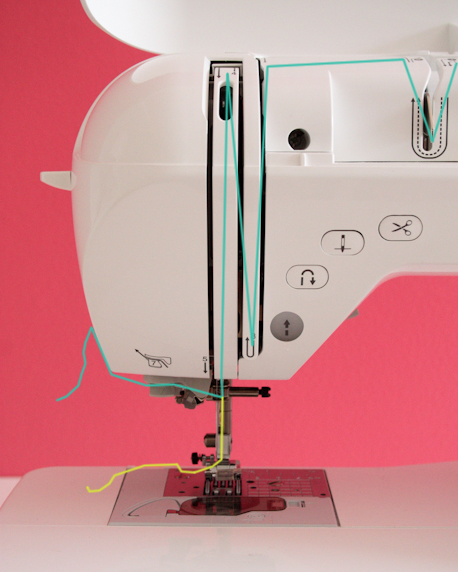Let’s play a game! The first person to tell me how many times the word “spool” or a variant of the word is used in this post gets a free yard of fabric. I’m going to guess we’ll hit at least thirty. (Oh, by the way: congratulations to Jenn for winning the yard of fabric I offered up on Monday – I’m sticking it in the mail today!)
Today I’m going to walk y’all through winding and installing the bobbin & threading the machine. The past two years I have instructed high schoolers in my Art of Homemaking class I have found that this topic is one of the things that frustrates new sewists the most. (Special note: one of my lovely Sewing 101 students informed me yesterday in the comments section that “sewists” is the current word-of-choice for people who sew. Also, “fabric artists”. Fair enough, being a “sewer” kind of has a stinky ring to it.)
Anyway, I want to make the loading and threading process palatable and understandable. I don’t want you to avoid your machine because (or switching to the appropriate thread color!) because you dread the task of getting it all set up. This should be a simple, mindless part of the process – at least after a bit of practice.
WINDING THE BOBBIN
A couple of important notes right off the bat:
1. bobbin spools: it is of utmost importance that you are using a bobbin spool that is made for your machine. This may sound like a silly detail, but there are several different sizes and shapes of bobbin spools and one size does not fit all. Several years ago I was using a too-small bobbin in my machine and having all kinds of maddening tension issues. I was ready to send my machine to the glue factory (or is that horses…) when I realized that that tiny piece of plastic was throwing everything off. Not only can an ill-fitting bobbin spool mess with tension, it could actually damage your machine.
Consider yourselves warned.
2. another thing about bobbin spools: while you’re at it, load a ton. When I’m sitting down to load a bobbin with thread, unless I’m in a hurry I figure I may as well load 5-10. This way, the next 5-10 times I’m cruising along enjoying a project and my bobbin thread runs out, it’s not a big hairy deal. I just grab another one, pop it in and keep humming away. Future you will thank current you. So do future you a favor and maybe go ahead and load a couple of dark bobbins, too!
3. spool caps: this is another size-does-matter issue. Your machine probably came with 2-3 different sizes of spool caps. These are the discs that slide onto your spool pin to keep your thread in place. Using a too-small spool cap could cause your thread to get caught in the stay-slit in your thread spool causing the thread – or even needle – to break. Not cool.
4. spool net – in the interest of being thorough I feel compelled to add spool nets to today’s lesson. When you are using thread that winds of quickly, such as transparent nylon thread or metallic thread, place a spool net (your machine probably came equipped with one) over the spool before placing the spool of thread onto the spool pin. (that’s six “spools” in point #4 alone. sheesh.)
Okay, enough of that. Now a photo, some written explanation, followed by a very long video to really make things clear. I hate to hear myself speak, so consider yourselves loved that these videos exist. Also, please pardon my very active hands – nobody wants a still screen, after all!
Photos:
I didn’t include the “under the hood” view of my machine in yesterday’s Know Your Machine post because I knew we’d cover it pretty thoroughly here today. I hope that didn’t throw any of you off.
I believe that most of the machine parts pointed out here are either already familiar to you or will be better explained as I walk you through the process in the video at the end.
THREADING THE MACHINE
Once you have your bobbin all plump and full, it’s time to thread the machine. This is another instance in which all machines not be exactly the same, but your machine will almost certainly have a solid line or numbered directions printed right on the body to walk you through the threading process. (In my machine’s case, the bobbin winding line is dashed, the machine threading line is solid.)
1. turn on the machine
2. raise the presser foot using the presser foot lever (I don’t know about yours, but if the presser foot is not raised, my machine cannot be threaded)
3. raise your needle by either turning your handwheel towards yourself or by pressing your “needle position button”
4. open the top cover (if you have one, of course)
5. remove the spool cap
6. place a spool of thread on the spool pin
7. slide the spool cap back onto the spool pin and be sure it’s on as far as possible
8. guide the thread behind the thread guide cover
9. then under the thread guide plate
10. then back up
We’re getting along nicely so far.
11. following your thread path indicated by your machine, being sure that your take-up lever (explained further in the video) is in the raised position.
12. as you bring your thread down through the end of the thread path, pass it behind the needle bar thread guide.
13. at this point you may either lower your presser foot and thread the needle directly from here (pictured below in green), or – if you have a needle threading function on your machine – you can go on with the last steps (pictured below in blue) so the machine can thread your needle for you.
14. in my machine’s case, I pass the thread through the thread guide disk from the front
15. then cut the thread with the thread cutter on the left side of the machine
16. lower the presser foot lever to lower the presser foot
17. pull down on the needle threader lever (also on the left of my machine) until it clicks.
18. raise the presser foot
19. and now in either case, be sure at least 2 inches of your thread tail is pulled to the back of your machine
… AND INSTALLING THE BOBBIN
Alright, here’s the situation. There are two types of bobbin housing on a sewing machine: drop-(or top-)loading & front-loading. My machine is loaded from the top, so that is very simple for me to demonstrate for y’all. However, I don’t have any front-loading machines here to photograph/take video of. Angst.
So. I will be as thorough as I can be in my video about how to install a top loading bobbin, but I’m in a bit of a bind for the front -loaders.
Here is what I can tell you:
When you install a bobbin in a top-loading machine, you do just that – drop it in. With a front loading machine, you actually remove the housing (pictured below), stick your bobbin inside, pull your thread through the hole, then snap it back into your machine. In the housing pictured below you can see that middle bar that goes across – you pull on that to lift and release the housing from the machine. And when your bobbin is properly loaded, you can’t see it at all, just this side of the housing.
I may see what I can do about borrowing a front loading machine this weekend and shooting a quick video tutorial. I will let you know when it has been added to this post.
In the meantime, the cru de gra of today’s post: a lengthy (and hopefully very helpful!) video that will walk you through winding your bobbin, installing it, and threading your machine:
Have a sweet Maundy Thursday, friends. I will be taking tomorrow off in observance of our Savior’s death. I plan to publish a lesson on machine feet on Saturday, no lessons on Sundays, Monday is for our Evie-girl, then we will pick up with actual stitching lessons Tuesday through Saturday. See you then!






i counted 25 spools but that could be wrong since i was concentrating on the lesson:)
20 times!
22 including the pic!
I got 24 including the pic. :) I actually just mastered this last week! I was so frustrated with my machine and ready to go buy a new one when I decided I just needed to start all over and act as though I had just gotten the machine and it made all the difference in the world! I must have messed something up the 1st time around.
I counted 23 in the text and 2 in the photos for a total of 25. :)
I am really enjoying this series!
i counted 25 spools but that could be wrong since i was concentrating on the lesson:) so excited about sewing next week!
23 including your first reference above!
PS Loving this series!
Actually, 25 including the two in the picture. Sorry for the comment spam! :)
And again, this is so amazingly helpful to wanna-be-sewers (seamstresses?) who are clueless!
Okay recounted and got 24 including picture spools!
Loving this series! I have a question about bobbin thread color. You said you wind 5-10 at a time and you said to make sure and wind some dark ones too. So my question is, are you supposed to use the same color thread in the bobbin as what you are sewing with, or just something close like a white and black depending on if your fabric is light or dark? I just always thought I was supposed to make a bobbin from the same thread I’m sewing with for that project, if I made 5 I would probably use up one bobbin and end up never needing that same color again. Does the bobbin thread not show from the top or something? Thanks for the help :)
I have the same question!
Hi Kathleen & Krista!
Bobbin thread color – good question. A lot of times I am sewing with fabric with pattern on it, so picking on perfect thread color isn’t possible. I go with white a lot for construction in these cases (construction stitches won’t show much if any), especially if the fabric is generally lighter. I will switch to a good color match for any topstitching – this will definitely show and you will want it to look good. But even then, I will often leave my bobbin thread white.
The same will apply for the (less often) cases when I’m sewing a generally dark patterned fabric.
And to answer your question, Kathleen, the bobbin thread does not show through the top – as long as your tension is good, etc. Still, it’s nice for it to be generally light or dark in case it can be seen.
Some folks may disagree with me on this and really choose to have your bobbin and thread match at all times and be very specific color-wise. It’s tricky with patterned fabric, but I definitely agree that a good color match is key (really top and bobbin) with any solid colored fabric projects.
I hope that was clear.
-R
Sorry for all the comments….this is saying that the video is private and won’t let me watch :(
Private video?? :(
Thanks Raechel for all your help and time! :)
So sorry, Katie! I’m so annoyed with myself that I forgot to uncheck that!
Girls! I’m SO sorry! The video is public now!!!
23 times + 2 in the picture= 25
I have no idea why, but I always struggle with picking up the bobbin thread. Your machine looks so simple! Thank you!
Lisa, my best advice on that is just make sure you hold on to your upper thread and turn that handwheel toward you slowly. Should be able to catch it that way.
25
also, my machine came with none of the fancy things you say they should come with. So, phooey. I already disliked my machine a lot. Now, there’s a *very* strong desire to send it to the glue factory since it seems to be lacking so many important things.
haha – sorry Tracy! Does it not have directions on the body for threading? I guess if it doesn’t, you have my directions now!
25, including the pic, or 23 without the pic. :)
My mom (an amazing seamstress) laughed at me a couple of months ago when I told her I needed to “buy new bobbin thread.” hahaha! She taught me how to fill up mine over the phone. So yay, a lesson that I already knew! Can’t wait to start making! :)
my first sewing machine was a free hand me down and it didnt have a work bobbin winder (i even made the lady at the sewing machine repair place look at it). so i would literally fill my bobbins by hand, wrapping the thread around and round. my love for the hobby was true.
Well I’m fresh out of the box looking for tips and hints help on a machine trying to pick right one for sewing and quilting open for tips ideas Ty
I have been looking EVERYWHERE for a bobbin box like that! Everything I have tried just seems to fit poorly. Where on earth was that and why can’t I find it?
very insightful,, thanks!
also it is coup de grace not cru de gra :)